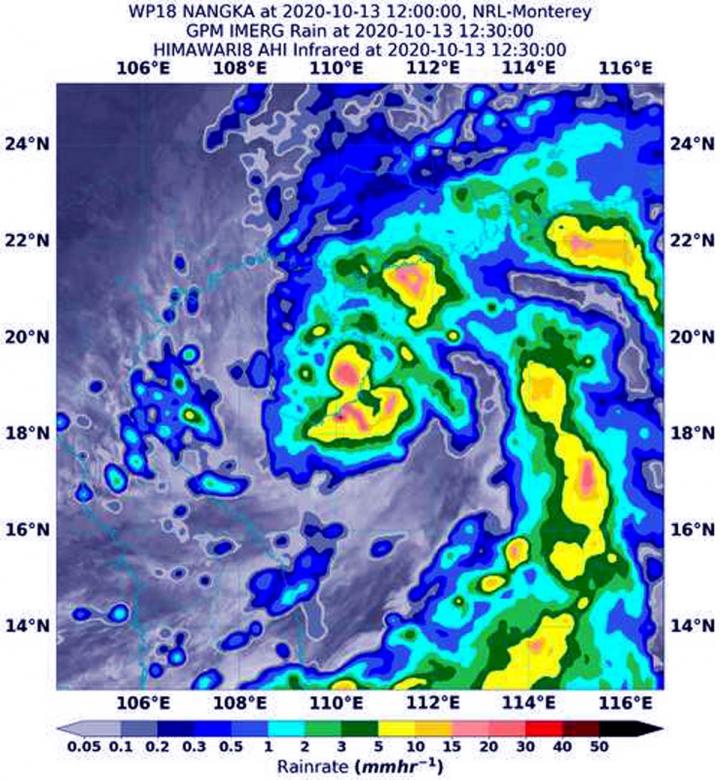
Credit: Credit: NASA/NOAA/NRL
Using a NASA satellite rainfall product that incorporates data from satellites and observations, NASA estimated Nangka’s rainfall rates as the storm soaked Hainan Island, China early on Oct. 13 (EDT).
Nangka formed in the South China Sea and moved in a westerly direction over the last couple of days.
Nangka’s Status on Oct. 13
At 11 a.m. EDT (1500 UTC), the center of Tropical Storm Nangka was located near latitude 19.1 degrees north and longitude 110.0 degrees east just over Hainan Island, China. It is about 286 nautical miles east-southeast of Hanoi, Vietnam. Nangka is moving toward the west-northwest.
Maximum sustained winds are near 50 knots (58 mph/93 kph) with higher gusts. Nangka is forecast to strengthen slightly in the Gulf of Tonkin (the body of water between Hainan Island, China and Vietnam) and then weaken as it moves toward Vietnam.
Estimating Nangka’s Rainfall Rates from Space
NASA’s Integrated Multi-satellitE Retrievals for GPM or IMERG, which is a NASA satellite rainfall product estimated on Oct. 13 at 8 a.m. EDT (1200 UTC) that Nangka was generating as much as 30 mm (1.18 inches) of rain per hour around the center of circulation.
Rainfall throughout most of the storm and in fragmented bands of thunderstorms north and east of the center was estimated as falling at a rate between 5 and 15 mm (0.2 to 0.6 inches) per hour. At the U.S. Naval Laboratory in Washington, D.C., the IMERG rainfall data was overlaid on infrared imagery from Japan’s Himawari-8 satellite to provide a full extent of the storm.
What Does IMERG Do?
This near-real time rainfall estimate comes from the NASA’s IMERG, which combines observations from a fleet of satellites in near-real time to provide near-global estimates of precipitation every 30 minutes. By combining NASA precipitation estimates with other data sources, we can gain a greater understanding of major storms that affect our planet.
What the IMERG does is “morph” high-quality satellite observations along the direction of the steering winds to deliver information about rain at times and places where such satellite overflights did not occur. Information morphing is particularly important over the majority of the world’s surface that lacks ground-radar coverage. Basically, IMERG fills in the blanks between weather observation stations.
NASA Researches Tropical Cyclones
Hurricanes/tropical cyclones are the most powerful weather events on Earth. NASA’s expertise in space and scientific exploration contributes to essential services provided to the American people by other federal agencies, such as hurricane weather forecasting.
For more than five decades, NASA has used the vantage point of space to understand and explore our home planet, improve lives and safeguard our future. NASA brings together technology, science, and unique global Earth observations to provide societal benefits and strengthen our nation. Advancing knowledge of our home planet contributes directly to America’s leadership in space and scientific exploration.
For more information about NASA’s IMERG, visit: https:/
For updated forecasts, visit the Hong Kong Observatory: https:/
By Rob Gutro
NASA’s Goddard Space Flight Center
###
Media Contact
Rob Gutro
[email protected]
Original Source
https:/




